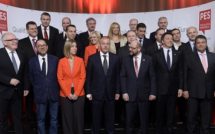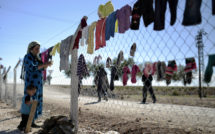
 The Berlin Wall may have fallen twenty-five years ago, but Germans still talk about “Die Mauer im Kopf”—the wall in the head—the cultural and psychological divisions between East and West that continue to endure. Ben Gook’s Divided Subjects, Invisible Borderlands: Re-Unified Germany After 1989, examines the unfinished business of reunification. Gook focuses on the image of East German difference and outlines the ways in which East German identity was forged in a succession of oppositions: to fascism, to capitalism, and ultimately, to contemporary German identity.
The Berlin Wall may have fallen twenty-five years ago, but Germans still talk about “Die Mauer im Kopf”—the wall in the head—the cultural and psychological divisions between East and West that continue to endure. Ben Gook’s Divided Subjects, Invisible Borderlands: Re-Unified Germany After 1989, examines the unfinished business of reunification. Gook focuses on the image of East German difference and outlines the ways in which East German identity was forged in a succession of oppositions: to fascism, to capitalism, and ultimately, to contemporary German identity.
Fundamental differences between East and West were of course broadly apparent prior to reunification, but East German identity as it exists today was formed primarily in retrospect. During division, German citizens did not see themselves as belonging to one of two opposing subgroups, “East German” and “West German.” West Germans would have called themselves simply “German,” East Germans, “Citizens of the German Democratic Republic,” with regional identities taking precedence in both countries. It was only afterwards, Gook explains, when Easterners and Westerners were able to confront each other—when each was faced with the other’s foreign clothing, consumer goods, and habits—that distinct identities opposing East and West began to emerge. Thus the process of reconciliation that took place throughout the early 1990s, aimed at eliminating difference, actually produced it. After all, despite the East German protest slogan “Wir sind ein Volk” (We are one people), reconciliation necessitates the existence of multiple identities to reconcile.
Gook sees hopefulness in this origin story. Reconciliation began as the union of two opposing categories that nonetheless had a shared history, each having been forged in the aftermath of World War II. He describes the moment after the Wall fell, when “east and west were equal and presented a vision of solidarity” (Gook 282). Yet shortly thereafter the East emerged as the losing side. A famous joke went, “An East German says to a West German, ‘We are one people,’ and the West German replies, ‘So are we.’” The East rapidly became an object of morbid fascination, myth, and nostalgia.
Subjects such as culture and identity are difficult to pin down. Gook, an investigator at the ARC Center of Excellence for the History of Emotions at the University of Melbourne, takes a thoroughly interdisciplinary approach, examining East German culture via politics, popular culture, film, and ethnography. Across these varied objects of study his analysis remains primarily psychoanalytical. This lens fits some themes better than others, but ultimately leads to some of the book’s most provocative insights. The book is broken into four sections, each centered around a different theme: the politics of reunification and the emergence of East German identity; nostalgia and Ostalgie, or nostalgia for the former East; contemporary films that depict East Germany; and exhibitions and ceremonies that commemorate both the former East and reunification. Each section consists of two or three short chapters bookended by an introduction and conclusion. These self-contained sections can feel disjointed, but they also make the book a faster read than its length would suggest, as each individual part is relatively succinct. One imagines too that the sectioned structure would lend the book well to a class or seminar context, where the section on, for instance, East Germany on film, could be read on its own with no loss of context.
The first and second sections are where Gook’s psychoanalytic approach shines. In the first section, he examines Freudian Nachträglichkeit writ large on a cultural scale. Nachträglichkeit, which encompasses both a belated examination and understanding of the past and, thereby, the continued relevance of the past in the present, informs the retrospective creation of the immutable, opposing categories of East and West German. He sees reunification as a Lacanian point de capiton, a moment in which certain ideologies, frameworks, and subjectivities crystallize, and thus help us make sense of the past. Reunification brings the articulation of a new symbolic order, one populated by Ossis and Wessis, Begrüßungsgeld and Trabis, Kaufhallen and Supermärkte. East Germans, associated with all things past, Gook terms “allochronic,” a biological term used in social sciences to describe two groups that inhabit different time periods. Nachträglichkeit dooms East Germans to move on a temporal and historical scale that lags behind that of the West.
In the second section, Gook examines Ostalgie, or nostalgia for the former East. While Ostalgie is often considered a broad cultural phenomenon, encompassing the films analyzed in later chapters, TV shows, museums, hip vintage stores, and eBay categories, Gook focuses solely on individual experiences: the choice to keep something East German, and therefore old and unfashionable, out of a sense of nostalgia. Most of these examples come from ethnography, and one wishes there were more ethnographic detail cited to shed greater light on the phenomenon. Still, Gook’s point is clear: we should think of these things as fetish objects. Their reassuring physicality allows their owners to escape the popular narrative that the West is superior, modern, the site of progress. By holding onto things, one can cling to the fantasy that time’s relentless march might be held in check. Gook’s psychoanalytic reading thus provides a new way of thinking about a well-trod topic.
The third and fourth sections focus more on description than analysis. The change in style gives the reader a greater understanding of Gook’s subject, whose clarity is sometimes lacking in the more analytical sections. He approaches internationally acclaimed films such as Goodbye, Lenin! and The Lives of Others—films that depict a foreign East for a Western audience—as tools for eliminating the oppositional nature of East German identity. They forward, he writes, the belief that “a good, homely Germany would be possible if only these nostalgics would stop being nostalgic and wholly join reunified Germany” (147=), thus opening up a space of hope for real unification.
In the fourth section, Gook describes recent museum and gallery exhibitions that present a new vision of the now-long-gone East. The shows, Thomas Heise’s Material at the Akademie der Künste and the group show Ostzeit at the Haus der Kulturen der Welt, focus on personal experiences and everyday life, devoid of the popular narrative of Stasi oppression. In this section, Gook’s subject is the East as it is understood to have been via its portrayal and commemoration in the present. His description of having been present at the ceremony commemorating the 25th anniversary of reunification, which took place in Berlin in 2014, is particularly illuminating. There, he leads the reader through the ceremony as he comes to recognize its ambiguous subject. Is it celebrating freedom, despite international surveillance systems that put the Stasi to shame? Unified nationhood, despite a persistent emphasis on the reconciliation of two opposing groups? Or merely recognizing its audience as national subjects? Ultimately, Gook concludes, it provides a way for the West—which consumed the East both politically and, in large part, culturally—to see itself through East German eyes. By constantly returning to 1989 and 1990, “the West Germans also came to fall in love with an idealized, a fantasized Germany again, one that at last seemed to embody the promise of its grounding postwar commitments” (259). Commemoration is Nachtraglichkeit—it carries the past into the future—but it is also a way to celebrate the promise of a unified Germany, one where all citizens would have equal claim to national belonging, a future towards which Germany still strives.
One point of contention is that throughout the book, Gook uses the terms Ossi and Wessi to describe former East Germans and former West Germans. To use the latter would be unwieldy, and no other succinct term exists. Gook is making the best of a difficult situation. However, while Ossi and Wessi are widely used terms, they are far from the definitive, official categories that Gook portrays them as being. While they have lost their pejorative nature over time, Ossi and Wessi still often carry a negative connotation; they are something to call the opposite side.
As Gook points out, the problem of divided identities in Germany is not something that is dying out with younger generations. Young people raised by East German parents, many born during the last years of the regime, have founded a national group called Dritte Generation Ost (Third Generation East), which organizes conferences and publishes books aimed at understanding their identity as not-quite-Westerners. Despite the new generations who have been born and raised in unified Germany, reunification has proved itself to be an unfinished process. Overall, this book provides a fresh analytical approach to the persistent puzzle of divided identities.
Reviewed by Samantha Fox, Columbia University
Divided Subjects, Invisible Borders, Re-Unified Germany After 1989
by Ben Gook
Rowman & Littlefield
Hardcover / 326 pages / 2015
ISBN: 9781783482412
To read more book reviews, please click here.
Published on February 1, 2017.




